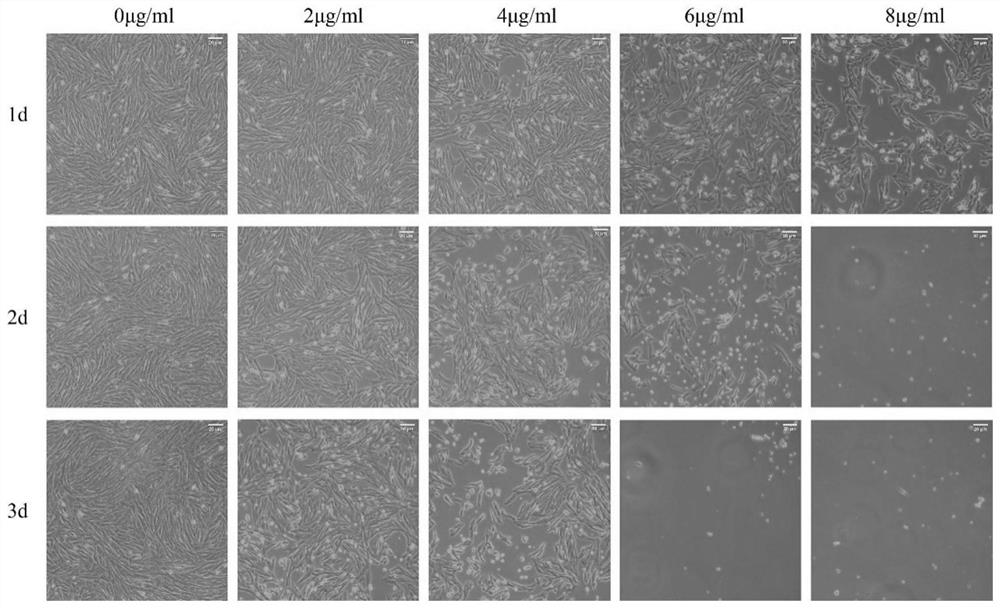SgRNA with duck hnRNPA3 gene knocked out, cell line and construction method and application of cell line
A construction method and cell line technology, applied in the field of sgRNA to knock out duck hnRNPA3 gene, to achieve the effect of improving the amplification level
- Summary
- Abstract
- Description
- Claims
- Application Information
AI Technical Summary
Problems solved by technology
Method used
Image
Examples
Embodiment 1
[0030] Plasmids, cells, viruses: lentiCRISPR-v2 plasmid was purchased from Addgene, number #83480; plasmid pCMV-VSV-G was purchased from Addgene, number #8454; plasmid psPAX2 was purchased from Addgene, number #12260; immortalized duck embryo fibroblasts ( DEF) was purchased from Cybekon (Shanghai) Biotechnology Co., Ltd.; DH5α competent cells were provided by the Poultry Disease Control Center of Sichuan Agricultural University College of Veterinary Medicine; HEK293T cells were purchased from Wuhan Punosai Life Technology Co., Ltd.; Su virus (TMUV) was provided by the Center for Poultry Diseases, College of Veterinary Medicine, Sichuan Agricultural University.
[0031] 1. Construction of expression vector lentiCRISPR-v2-Blast plasmid
[0032] Schematic diagram of sgRNA targeting duck hnRNPA3 gene and expression vector lentiCRISPR-v2-Blast plasmid figure 1 shown. Use BsmBI endonuclease to linearize the lentiCRISPR-v2 vector. The linearization system and procedure are as foll...
Embodiment 2
[0045] Validation of TMUV proliferation on hnRNPA3 knockout cell lines
[0046] Set up test group 9-1clone and control group DEF (IM), the test group inoculates the DEF of hnRNPA3 gene knockout prepared in embodiment 1 into 12 well plates, and each group is set to repeat three times; Duck embryonic fibroblasts (naive DEF) were seeded into 12-well plates, and each group was set up in triplicate. When the cell density of the test group and the control group reached 80-90%, they were infected with the same amount of TMUV. After 24 hours of infection, the supernatant was discarded, and the total RNA was extracted by Trizol method, and it was reverse transcribed into cDNA . Using fluorescent quantitative PCR (RT-qPCR), the expression of TMUV E gene relative to the internal reference gene β-actin in the test group and the control group was detected, and the sequences SEQ ID NO.7 and SEQ ID NO.8 were used as the internal reference gene β-actin primers; use SEQ ID NO.9 and SEQ ID NO...
Embodiment 3
[0051] Validation of TMUV viral RNA translation on hnRNPA3 knockout cell lines
[0052] The test group 9-1 clone and the control group DEF (IM) were set up. The test group inoculated the hnRNPA3 gene knockout DEF prepared in Example 1 into a 24-well plate, and each group was set to repeat four times; the control group inoculated an equal amount of naive DEF were seeded into 24-well plates, and each group was set up in four replicates. When the density reaches 80-90%, transfect the TMUV translation system 5'UTR-Rluc-3'UTR respectively. After 4 hours of transfection, discard the supernatant, collect cell samples, and detect the level of Rluc in the cells, which represents the TMUV genome Translation situation. The results show that if Figure 5 As shown, the knockout of hnRNPA3 gene can significantly promote the translation level of TMUV RNA in duck embryo fibroblasts.
[0053] In summary, the present invention uses the CRISPR / Cas9 system to knock out the duck hnRNPA3 gene fr...
PUM
 Login to View More
Login to View More Abstract
Description
Claims
Application Information
 Login to View More
Login to View More - R&D
- Intellectual Property
- Life Sciences
- Materials
- Tech Scout
- Unparalleled Data Quality
- Higher Quality Content
- 60% Fewer Hallucinations
Browse by: Latest US Patents, China's latest patents, Technical Efficacy Thesaurus, Application Domain, Technology Topic, Popular Technical Reports.
© 2025 PatSnap. All rights reserved.Legal|Privacy policy|Modern Slavery Act Transparency Statement|Sitemap|About US| Contact US: help@patsnap.com



